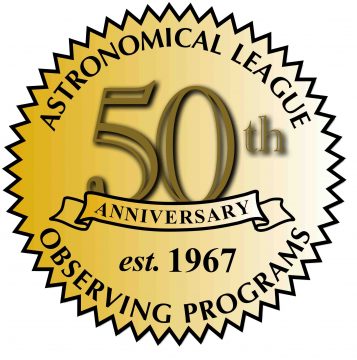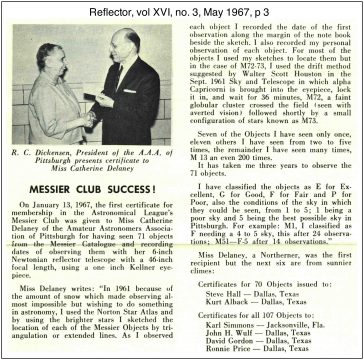Astronomy - Fifty Years of the Astronomical League Observing Programs
The Astronomical League, one of amateur astronomy's best institutional resources, has awarded more than 10,000 observing certificates since 1967.
 Amateur astronomers love to observe. Sometimes, though, they're not quite sure what to look at in the sky, or they might need a gentle nudge to get them outside under the stars. The Astronomical League's Observing Programs were meant to help with that — giving stargazers direction and encouragement. Most programs consist of a list of specific targets to examine, while a few also require a series of activities to complete. Observers who have their notes and sketches verified by their local astronomy club or the League are recognized with a specially-designed pin and a certificate of accomplishment.
Amateur astronomers love to observe. Sometimes, though, they're not quite sure what to look at in the sky, or they might need a gentle nudge to get them outside under the stars. The Astronomical League's Observing Programs were meant to help with that — giving stargazers direction and encouragement. Most programs consist of a list of specific targets to examine, while a few also require a series of activities to complete. Observers who have their notes and sketches verified by their local astronomy club or the League are recognized with a specially-designed pin and a certificate of accomplishment.
This month marks the 50th anniversary of the League's first observing program certificate. On January 13, 1967, Catherine Delaney, a member of the Amateur Astronomers Association of Pittsburgh (AAAP), was awarded Messier Observing certificate number 001. She was immediately followed by several observers from Texas and one from Florida, and the progression hasn’t stopped nor slowed since. (The League’s second observing program, the Herschel 400, also had its first certificate issued to an AAAP member, Tom Reiland in 1981.)
Fast forward 50 years. In that interval, nearly 3,000 Messier certificates have been earned by League members. Furthermore, 50 more observing programs have been launched, resulting in participants being presented with well over 10,000 total certificates. The current suite of programs represents nearly all facets of observing for enthusiasts at nearly all expertise levels. The observing topics and celestial features include meteors, Earth satellites, lunar, solar, planetary, double stars, variable stars, planetary nebulae, open clusters, globular clusters, and many different aspects of galaxies. Most programs require a telescope of a suitable aperture, but a few specify only binoculars. One even requires various forms of radio telescopes.
Not all programs deal with the activity of observing, per se. Perhaps the most important program for the continuance of our amazing avocation is the Dark Sky Advocate, requiring participants not only to recognize the scourge of light pollution, but to act in a way that positively affects their communities. The Astronomical League also realizes that it's vital to introduce people to amateur astronomy. In that light, the Outreach award, one of the League’s most popular programs, recognizes members on their extensive efforts to connect with the public.
This year, two new programs will be offered. The Total Solar Eclipse Program asks astroimagers to emulate Sir Arthur Eddington’s 1919 activities that confirmed Einstein’s newly presented Theory of General Relativity. It will undoubtedly be a challenge, but if all goes well, participants will be able to directly document the effects of our Sun’s immense gravitational field as it bends distant starlight. The other program, which will actually consist of two or three inter-related programs, will be about imaging a wide range of celestial features.
The Astronomical League will recognize the Amateur Astronomers Association of Pittsburgh for their role in this observing milestone during their January 13, 2017, meeting — 50 years to the day when their president, R.C. Dickensen, presented the first award to Catherine Delaney.
The Astronomical League is proud to administer this unique suite of nationally recognized Observing Programs. It's unlike any other in the universe!

No comments:
Post a Comment